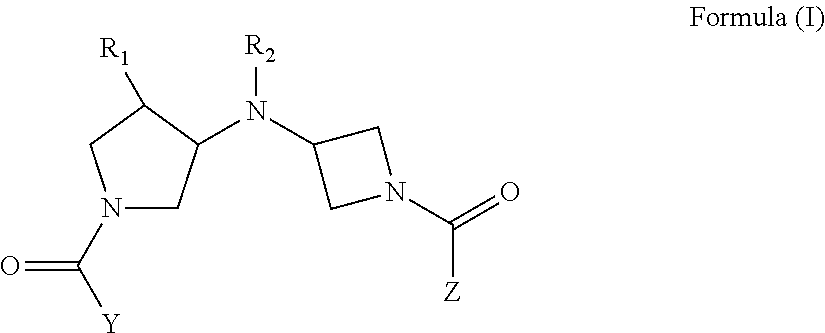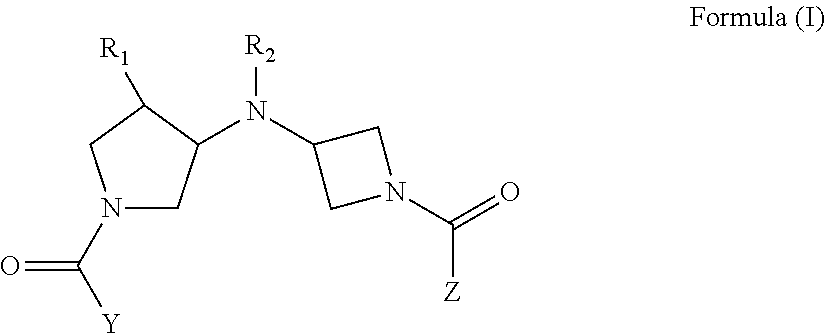Amino-pyrrolidine-azetidine diamides as monoacylglycerol lipase inhibitors
a technology of monoacylglycerol and azetidine, which is applied in the direction of biocide, heterocyclic compound active ingredients, drug compositions, etc., can solve the problem of difficult to separate the beneficial effects of these compounds from the unwanted side effects
- Summary
- Abstract
- Description
- Claims
- Application Information
AI Technical Summary
Benefits of technology
Problems solved by technology
Method used
Image
Examples
example 5
[0506]
A. (S)-Benzyl 3-((1-(tert-butoxycarbonyl)azetidin-3-yl)amino)pyrrolidine-1-carboxylate, 5b
[0507]To a solution of compound 5a (4.25 g, 19.3 mmol) and compound 1e (4.29 g, 25.08 mmol) in DCE (60 mL) was added acetic acid (3 mL). To this mixture was added Na(OAc)3BH (5.73 g, 27 mmol). The reaction was stirred at room temperature for 4 h. To the reaction mixture was added aq. NaHCO3, and the resultant mixture was extracted with CH2Cl2. The organic layer was dried over Na2SO4 and concentrated. Purification by flash column chromatography (silica gel, 2% MeOH / EtOAc+0.5% TEA) gave compound 5b (6.5 g). 1H NMR (300 MHz, CDCl3): δ 7.37-7.30 (m, 5H), 5.13 (s, 2H), 4.11 (m, 2H), 3.61 (m, 5H), 3.42 (m, 1H), 3.31 (m, 1H), 3.15 (m, 1H), 2.05 (m, 1H), 1.71 (m, 1H), 1.43 (s, 9H).
B. (S)-tert-Butyl-3-(pyrrolidin-3-ylamino)azetidine-1-carboxylate, 5c
[0508]A solution of compound 5b (1.3 g, 3.46 mmol), 10% Pd / C (200 mg) in EtOH (50 mL) was hydrogenated under 40 psi hydrogen pressure in a Parr appara...
example 6
[0514]
A. (3S)—N-Ethyl-1-(phenylcarbonyl)-N-(1-{[3′-(trifluoromethyl)biphenyl-4-yl]carbonyl}azetidin-3-yl)pyrrolidin-3-amine, Cpd 53
[0515]To a solution of Compound 16 (50 mg, 0.101 mmol) in dry DMF (1 mL) was added NaH (6 mg, 0.152 mmol) and the resulting mixture was stirred at room temperature for 20 min. EtBr (0.012 mL, 0.12 mmol) was added and the reaction mixture was heated to 130° C. overnight. The resultant mixture was diluted with EtOAc and water. The organic layer was washed with water and aq. NaHCO3, dried over Na2SO4, filtered, and concentrated under reduced pressure. Purification of the residue by flash column chromatography (silica gel, 5% MeOH / EtOAc+0.5 TEA %) gave compound 53 (9 mg). MS m / z (M+H+) 522.0.
example 7
[0516]
A. (3S)—N-Hydroxy-1-(phenylcarbonyl)-N-(1-{[3′-(trifluoromethyl)biphenyl-4-yl]carbonyl}azetidin-3-yl)pyrrolidin-3-amine, Cpd 54
[0517]To a solution of Compound 16 (60 mg, 0.12 mmol) in dry CH2Cl2 (1 mL) was added mCPBA (77%, 33 mg, 0.146 mmol) at 0° C. and the resulting mixture was stirred at this temperature for 30 min. The reaction mixture was diluted with CH2Cl2 and water. The organic layer was washed with water and brine, dried over Na2SO4, filtered, and concentrated under reduced pressure. Purification of the residue by flash column chromatography (silica gel, 5% MeOH / EtOAc) gave compound 54 (7 mg). MS m / z (M+Na+) 510.0, MS m / z (M+Na+) 532.0.
[0518]Following the procedure described above for Example 7 and substituting the appropriate reagents, starting materials and purification methods known to those skilled in the art, the following compounds of the present invention were prepared:
[0519]
CpdCpd Name and Data34(3S)-N-{1-[(5-Bromonaphthalen-2-yl)carbonyl]azetidin-3-yl}-N-hyd...
PUM
 Login to View More
Login to View More Abstract
Description
Claims
Application Information
 Login to View More
Login to View More - R&D
- Intellectual Property
- Life Sciences
- Materials
- Tech Scout
- Unparalleled Data Quality
- Higher Quality Content
- 60% Fewer Hallucinations
Browse by: Latest US Patents, China's latest patents, Technical Efficacy Thesaurus, Application Domain, Technology Topic, Popular Technical Reports.
© 2025 PatSnap. All rights reserved.Legal|Privacy policy|Modern Slavery Act Transparency Statement|Sitemap|About US| Contact US: help@patsnap.com



